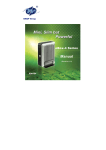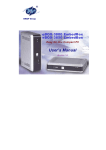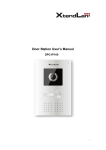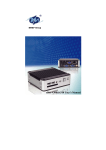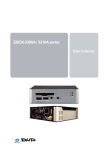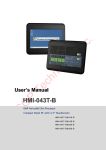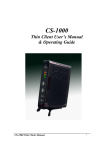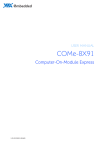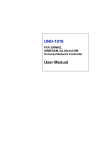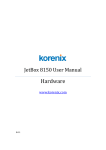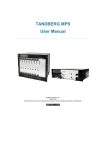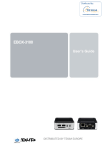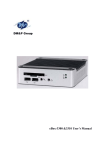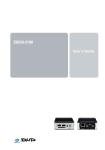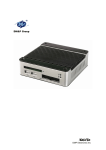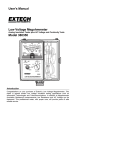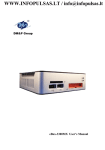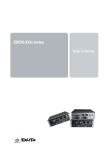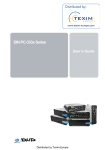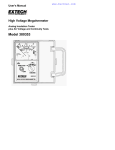Download Fanless Mini PC
Transcript
Fanless Mini PC TV-850B 1,2 GHz Mini PC, with TV out, LPT, 2xCOM, 1z LAN TC-850B 1,2 GHz Mini PC, 2xCOM, HDD sup., 1x LAN RB-851B 1,2 GHz Mini PC, with CF, miniPCI, 1x LAN RB-851BG 1,2 GHz Mini PC, with CF, miniPCI, HDD sup., 1x LAN RB-852B 1,2 GHz Mini PC, with CF, 2xLAN, miniPCI RB-853BS 1,2 GHz Mini PC, with CF, 2xLAN, HDD sup. User’s manual Table of Contents SAFETY INFORMATION .............................................................................................. 2 REGULATORY ............................................................................................................. 3 UNPACKING YOUR MINI PC ........................................................................................ 4 PREFACE ..................................................................................................................... 5 Mini PC Overview ...................................................................................................... 6 ABOUT EMBEDDED CPU BOARD................................................................................. 7 PERIPHERALS.............................................................................................................. 8 CONNECTING THE POWER ADAPTOR .................................................................. 8 CONNECTING THE MONITOR ............................................................................... 8 CONNECTING THE USB ......................................................................................... 9 CONNECTING USB, SPEAKER/EARPHONE AND WEB............................................ 9 CONNECTING THE KEYBOARD AND MOUSE ........................................................ 9 BIOS ......................................................................................................................... 10 RECONFIGURING Mini PC ................................................................................... 10 TECHNICAL SPECIFICATION ...................................................................................... 11 TAKING CARE YOUR COMPUTER .............................................................................. 12 STORING ............................................................................................................. 12 USING CABLES FOR CONNECTION...................................................................... 12 CLEANING YOUR COMPUTER ............................................................................. 12 TROUBLESHOOTING ................................................................................................. 13 REAR PANEL ............................................................................................................. 14 REAR CONNECTORS OUTLINE FOR Mini PC TC-850B ......................................... 14 REAR CONNECTORS OUTLINE FOR Mini PC RB-851B ......................................... 14 REAR CONNECTORS OUTLINE FOR Mini PC RB-852B / RB-853BS ...................... 15 REAR CONNECTORS OUTLINE FOR Mini PC TV-850B ......................................... 15 PIN ASSIGNMENTS................................................................................................... 16 1 SAFETY INFORMATION WARNING Do not expose your computer to rain or moisture, in order to prevent shock and fire hazard. Never install your computer in wet locations. Do not open the cabinet to avoid electrical shock. Refer to your nearest dealer for qualified personnel servicing. Never touch un-insulated terminals or wire unless your power adaptor and display monitor are disconnected. Locate your computer as close as possible to the socket outline for easy access and to avoid force caused by entangling of your arms with surrounding cables from the computer. When using Mini PC, avoid using or installing the modem to the serial port during a storm or a lightning. Do not use the modem or a telephone to report a gas leak in the vicinity of the leak. USB connectors are not supplied with Limited Power Sources. DO NOT ATTEMPT TO OPEN OR TO DISASSEMBLE THE CHASSIS (ENCASING) OF THIS PRODUCT. PLEASE CONTACT YOUR NEAREST DEALER FOR SERVICING FROM QUALIFIED TECHNICIAN. 2 REGULATORY FCC CLASS A NOTE This equipment has been tested and found to comply with the limits for a Class A digital device, pursuant to Part 15 of the FCC Rules. These limits are designed to provide reasonable protection against harmful interference when the equipment is operated in a commercial environment. This equipment generates, uses and can radiate radio frequency energy and, if not installed and used in accordance with the instruction manual, may cause harmful interference in which case the user will be required to correct the interference at his own expense. Testing was done with shielded cables. Therefore, in order to comply with the FCC regulations, you must use shielded cables with your installation. WARNING This product Complies with EN55022 Class A. In a domestic environment this product may cause radio interference in which case the user may be required to take adequate measures. Changes or modifications to this unit not expressly approved by the party responsible for compliance could void the user’s authority to operate the equipment. This device complies with Part 15 of the FCC rules. Operation is subject to the following two conditions: (1) this device may not cause harmful interference, and (2) this device must accept any interference received, including interference that may cause undesired operation. This digital apparatus does not exceed the Class A limits for radio noise emissions from digital apparatus as set out in the interference - causing equipment standard entitled “Digital Apparatus”, ICES-003 of the Department of Communications. Cet appareil numérique respecte les limites de bruits radioélectriques applicables aux appareils numériques de Classe (A) prescrites dans la norme sur le matériel brouilleur: “Appareils Numériques”,NMB-003 édietée par le miniistre des Communications. MANUFACTURER’S DECLARATION OF CONFORMITY This equipment has been tested and found to comply with the requirements of European Community Council Directives 89/336/EEC and 73/23/EEC relating to electromagnetic compatibility and product safety respectively. ATTENTION This product has been designed and certified to comply with certain regulatory requirements pertaining to Information Technology Equipment. This product has not been designed for use as a medical device. Without limitation of the foregoing, this product is not intended and has not been certified for use in a hospital or clinical environment to diagnose, treat, or monitor patients under medical supervision, and is not intended and has not been certified to make physical or electrical contact with patients, nor to transfer energy to or from patients and/or to detect such energy transfer to or from patients. 3 UNPACKING YOUR MINI PC Congratulation! You have just acquire Mini PC RB/TC/TV series, the world’s smallest and compact PC, please check the following items: PACKING LIST FOR Mini PC SERIES Item Description Q’ty c d Mini PC Max. 20-watts External Power Adaptor, Vin: 100~240VAC • 60/50Hz, 1.0A / Vout:: +5.0~5.25VDC @ 4A max. LPS Drivers CD for Mini PC User’s Manual x1 x1 e f x1 x1 * Note: The accessories are subject to change without immediate notice. CHECK BEFORE USE c Mini PC EmbedBox d AC Power Adaptor 4 e Drivers CD PREFACE Mini PC TV-850B/TC-850B/RB-851B/RB-851BG/RB-852B/RB-853BS XtendLan introduces an industrial classic in the computing industry, by featuring Mini PC RB/TC/TV series, a chef d’oeuvre compact PC that connects people through networking via global internet across the continents over the channels of sea bay. The conquest for browsing e- information through wired LAN/WAN. This portable device is handy for travelers and service technicians who worked in and out of the office. For office desk workers, this showpiece occupies very little space on a corner of the table, and it is so convenient that you may lock it in your drawer after office hours. A jewel in the crown Mini PC RB/TC/TV series for thin client users, which is handy-rugged-robust. Mini PC RB/TC/TV series serves as the Internet Appliance that offers state-of-art design for applications surrounding networking, computing, transaction and information transport. XtendLan connotes the Mini PC RB/TC/TV series for small business enterprises to serve these boxes to users for the connection to a server as thin client. The Mini PC RB/TC/TV series achieves multi-servers requirement to serve as firewall, mail-server, print server, and many other single task application in the office. Furthermore, with Mini PC RB/TC/TV series, business executive can work his way from the office to home, a student can do his assignment from the dormitory and continue back at home. Mini PC RB/TC/TV series allows you to use your computer with just one finger press at the power button. It is built in an awesome mechanical dimension of 170×124× 56mm, this is just a right device for space conscious environment. 5 Mini PC Overview Front Panel Power LED The power LED lights up, when system is turn on. HDD LED The HDD LED flashes when the system is working. Please do not turn off the system when HDD start running Power Switch Depress switch to turn on & turn off the systems. USB port For connection to devices with USB interface (keyboard, mouse, HDD, CDROM, Memory Stick, etc.) 6 ABOUT EMBEDDED CPU BOARD SYSTEM SPECIFICATION CPU Keyboard and Mouse VIA Esther 1.2GHz PS/2 Keyboard and Mouse North/South Bridge VIA CX700M On-Board IDE Support PIO, Bus Master, and Ultra DMA/66 operation. Can connect to 2 IDE devices. Main Memory 512MB DDR2 (1GB RB-851BG) BIOS “Plug and Play” function, auto-search new apparatuses inset. Provide DMI for system management. Advanced ACPI configuration and power control interface. ( intelligence control system.) Peripheral 1. Printer port x1 (support SPP/EPP/ECP module) 2. USB2.0 ports x2 3. Serial port 4. Rear Audio (Mic-in, Line-out) Dimension & Weight 170 x 123 x 56 mm / 970g VGA AGP Rev.2.0 Compliant Resolution up to 1920x1440 Operating System Suitable for – Windows XP Windows XP Embedded Windows Embedded CE WEPOS LINUX Audio AC97 CODEO, Fully Compliant with AC97v2.1 LAN Realtek 8100B 10/100Base-Tx Ethernet Interface 7 PERIPHERALS CONNECTING THE POWER ADAPTOR Power Adaptor To use your computer immediately, take and use the supplied AC adapter as a power source. See the left diagram for visual connection. Connect the DC power jack of the power adaptor to the DC Input jack of Mini PC. Turning ON Your Computer Press the power button as indicated on the figure on your left-side, the system will start automatically. CONNECTING THE MONITOR VGA Connection Depending on your choice of viewing, select a conventional CRT or the LCD VGA monitor. 8 CONNECTING THE USB Mini PC provides USB port (one each in front & at the back of the cabinet). Turning ON Your Computer Front cabinet Press the power button as indicated on the figure on your left-side, the system will start automatically. CONNECTING USB, SPEAKER/EARPHONE AND WEB USB Port The second USB port is available for connection to USB devices. Connecting to WEB There is an available RJ-45 LAN jack for connection to the hub of your intranet; and via your server for internet service (see diagram for RJ-45 LAN jack). Speaker/Earphone Mini PC supports Input/Output device for speaker, earphone and MIC (Microphone), etc… CONNECTING THE KEYBOARD AND MOUSE Describing Mouse actions Description Action Point - Click - Double-click Right-click Scroll wheel - Slide and point your mouse to your desired position. Press the left button once. Press the left button twice. Press the right button once. When selecting (most) programs, this action displays a shortcut menu of the contextsensitive choices. Move your finger along the wheel of your mouse (just upright your middle finger) and scroll vertically to move page upward and downward. Describing Keyboard The keypad usually comes in standard QWERTY; except that different language(s) keyboard comes with additional special characters.. 9 BIOS RECONFIGURING Mini PC 1. 2. 3. 4. Take note that AMI BIOS is used in the Mini PC. To reconfigure the computer, depress or hit the <Del> key to enter your BIOS setup main menu. Select from the menu, the desired setup for change. Press <Esc> to go back to main menu. Move your cursor to “Save Settings and Exit”, press “Y” to save the changes that you just made. Mini PC will restart accordingly to your new setup. 10 TECHNICAL SPECIFICATION Features CPU BIOS System Chipset I/O Chip System Memory Expansion I/O MIO USB Compact Flash Slot Mini PCI Socket Display Chipset Description VIA Esther 1.2GHz AMI BIOS VIA CX700M VT1211 Onboard 512MB DDR2 (1GB RB-851BG) 1x X-PCI connector EIDE (Ultra DMA 133), 1x PS/2 K/B and Mouse Print and RS-232 Port USB 2.0 Ports (one in front) Type I/II compact flash slot 124pin Mini PCI socket Integrated VIA UniChrome 2D/3D Graphics with MPEG4/WMV9 Accelerator Up to 64 MB share system memory Up to 1920 x 1440 Display Memory Resolution CRT Audio AC97 2.2 (Codec) VIA Vinyl VT1708 Audio Interface Line out, , Mic in Ethernet Chipset Realtek 8100BT Remote Boot ROM Built-in boot ROM function Mechanical &Environment Power Requirement+ 5V~5.25V @ 4A Operating Temperature0 0 ~ 60oC Operating Humidity0% - 90% relative humidity, non-condensing Size (W x H x D) 170 x 123x 56mm Weight780 780g / 940 g 11 TAKING CARE YOUR COMPUTER This section gives you guidelines on using Mini PC computer – Safe using, Storing and Handling. STORING Do not place your computer in a location that is subject to: Heating sources, such as stove, oven, heater, radiator or air duct Direct contact from sunlight Rain or moisture area Excessive dust accumulation area High humidity place Constant or occasional mechanical movement, vibration or shock Strong magnets or magnetic fields or magnetically unshielded speakers Ambient temperature of more than 95oF (35oC) or less than 32oF (0oC) Do not place other electronic device or electrical equipment near your computer. The electromagnetic field of the computer may cause interference subjecting to malfunction. Provide adequate air ventilation (circulation) to prevent internal buildup of heat. Do not place your computer near the wall, behind the curtains or draperies, in between two books that block its ventilation slots. Leave a space of at least 8 inches (20cm) behind the sides and back panel of the computer. Change of environmental temperature: Problems may occur when there is a sudden change of environmental temperature, or if the computer is brought directly from a cold location to a warm one, moisture may condense inside your computer. Turn off your computer, and contact your nearest dealer. Checking the surrounding appliance(s) before using your computer. Since the computer uses high-frequency radio signal and may interface with radio or TV reception causing interference or poor signal display. When this happens, relocate the computer by a suitable distance away from the set. Do not drop the computer from the working table nor place heavy objects on top of the computer. USING CABLES FOR CONNECTION To avoid problem, use only the specified interface cables in your accessory bag. The supplier will not be responsible for the connection arising from the other unspecified peripheral equipment. Do not use cut or damaged cables for connection. CLEANING YOUR COMPUTER Clean the computer with a soft, dry cloth or a soft cloth lightly moistened with a mild detergent solution. Do not use any type of abrasive pad, scouring powder, or solvent such as alcohol or benzine, as these may damage the finish of your computer. When a solid object falls or a liquid spills onto the computer, turn off the computer immediately and unplug the LAN and power cables. Contact a qualified person or your dealer to check the computer before you use it again. Always disconnect the power cord from the power source before cleaning the computer. 12 TROUBLESHOOTING This section describes the techniques of resolving some basic problems that you encounter when using your computer. For more troubleshooting guidelines, please contact your nearest dealer for technical support. TROUBLESHOOTING YOUR EMBEDBOX A. Computer does not start Make sure the computer is properly secured and plugged into a power source before it is turned on. Make sure the power indicator shows the power is on. When the computer is plugged into a power strip or the UPS (Uninterruptible Power Supply), make sure the power strip or UPS is turned on and working normally. Check if your VGA or LCD monitor is properly plugged into a power source and turned on. Make sure the brightness and contrast controls are adjusted correctly. See the manual that came with your display (monitor) for details. Check if your power control button does not function, by removing the AC adaptor. Wait for one minute, and then reattach all power connection before pressing the power button. Condensation may cause the computer to malfunction for a while. If this happens, do not use the computer for at least one hour. When you have checked all the above guidelines and the computer does not work. Remove the power adaptor from the computer, unplug the power cord, and plug it in again. Then turn on the power. B. BIOS Error Message – BIOS error message appear when my computer starts If the BIOS error message appears, press any key to resume or, hit <DEL>to enter BIOS setup main menu, follow these steps: 1. Press <DEL>, and the BIOS Setup main menu appears, check if HDD is detected at “Pri Master”. If it is not detected, use “Sel” keys <↑↓> to choose “AUTO”, then go back to the main menu by pressing <ESC>. Move your cursor down with “Sel” keys <↓>, and choose “Save Settings and Exit”, a message dialog appears as seen below, hit <Enter>. “Save current settings and exit (Y/N)? Y ” 2. Go to “Auto Configuration with Optimal Settings” using the “Sel” keys <↑↓>, then press <Enter>. A message dialog appears as seen below, hit “ Y ” key and press <Enter> to save and recover the factory setting. “Load high default settings (Y/N)? N ” C. “Operating System Not Found” – A message indicating that “Operating system not found” appear when my computer starts (Windows won’t start) Enter your BIOS setup main menu by pressing <DEL> key, be sure that your C: drive is enable. If Windows still does not start, follow these steps to initialize the BIOS: 1. Turn off the computer. 2. Remove any peripheral devices connected to the computer. 3. Restart the computer.. 4. Press <DEL> to enter BIOS Setup main menu window. 5. Follow the steps as written in item B. BIOS error message. If you have just connect your computer to a USB Devices, remove these peripherals.. And restart your computer to confirm that the Windows operating system starts properly. If your computer continues to display the message ”Operating system not found,” and Windows does not start, please contact your nearest dealer for servicing. 13 REAR PANEL REAR CONNECTORS OUTLINE FOR Mini PC TC-850B DC Power Jack Power Switch PS/2 KB / MS LAN Printer Port Mic In Line Out Serial Port REAR CONNECTORS OUTLINE FOR Mini PC RB-851B / RB-851BG DC Power Jack Power Switch PS/2 KB / MS LAN Serial Port Mic In Line Out Compact Flash slot 14 REAR CONNECTORS OUTLINE FOR Mini PC RB-852B / RB-853BS DC Power Jack Power Switch PS/2 KB / MS Serial Port LAN Mic In Line Out Compact Flash Slot 2nd LAN REAR CONNECTORS OUTLINE FOR Mini PC TV-850B DC Power Jack Power Switch PS/2 KB / MS LAN S-Video out Printer Port Serial ports 15 Mic In Line Out TV-out PIN ASSIGNMENTS Power Sw – Push Button Switch Pin # | O --- KBD(PS/2Keyboard & Mouse) – 6-pin Mini-Din Connector Pin # Signal Name 1 KBCLK 2 PMCLK 3 GND 4 KBDAT 5 PMDAT 6 SB5V 7 GND 8 GND 9 GND DC-IN (DC-IN 5V) – 3-pin MINI-DIN Lock Pin Socket Pin # Signal Name 1 J23-pin 1 & 2 2 SB5V NC 3 GND 4 Mouse (PS/2 Mouse) – 6-pin Mini-Din Connector Pin # Signal Name 1 PMCLK 2 NC 3 GND 4 PMDAT 5 NC 6 SB5V 7 GND 8 GND 9 GND RJ-45 FOXCONN (LAN) – RJ45 Connector Pin # Signal Name 1 FTXD+ 3 FRXIN+ 5 NC 7 NC VGA – 15-pin Dsub Connector Pin # 1 2 3 4 5 Signal Name MR MG MB NC GND Status ON OFF --- USB1 (USB1x90o)– 4-pin USB Type 1 Connector (Vertical Type) Pin # Signal Name 1 VCC 2 USB03 USB0+ 4 GND 5 GGND 6 GGND 7 GGND 8 GGND Pin # 2 4 6 8 Pin # 6 7 8 9 10 16 Signal Name FTXDNC FRXINNC Signal Name GND GND GND NC GND Pin # 11 12 13 14 15 Signal Name NC VCC HYSYNC VSYNC VCC MIC_IN – 5-pin RCA Phone Jack Pin # 1 2 3 4 5 COM - 9-pin Dsub Connector Pin # 1 3 5 7 9 USB (USB2): For connection to external USB device –4-pin USB Type 1 Connector (H) Signal Name GND MIC1 Open Touch Open Touch VREFOUT Pin # 1 2 3 4 5 6 Signal Name VCC USB2USB2+ GND NC NC LEDS: POWER ON/OFF & HDD R/W LED State Color Blue Power On Red HDD On Red HDD R/W Flashes Signal Name DCD1 TXD1 GND RTS1 RI1 Pin # 2 4 6 8 -- 17 Signal Name RXD1 DTR1 DSR1 CTS1 --


















